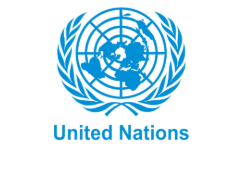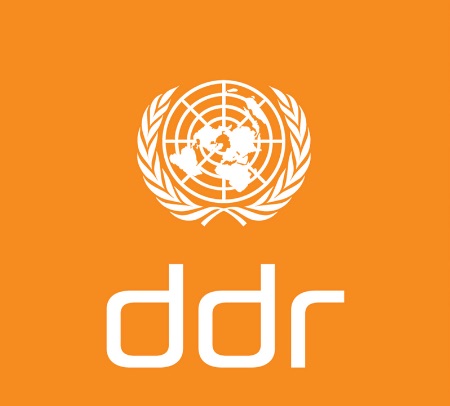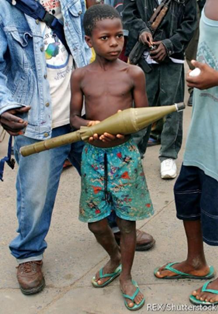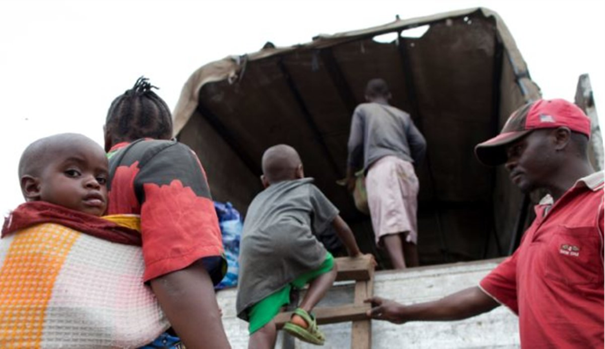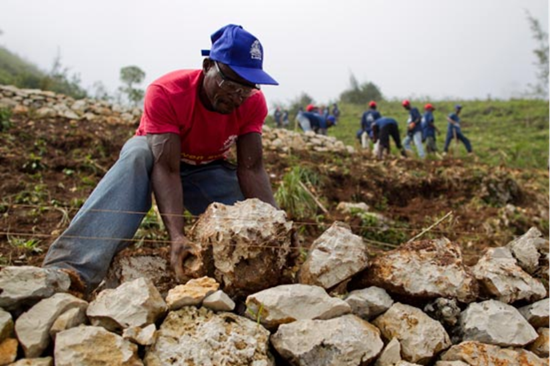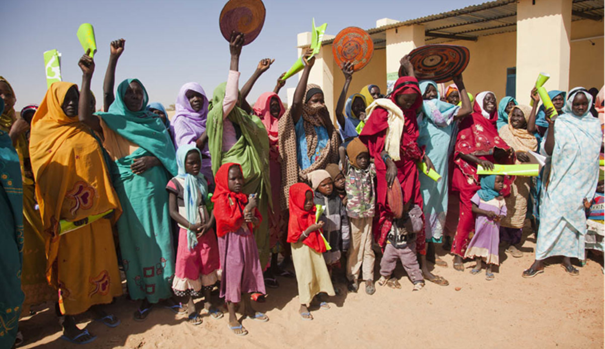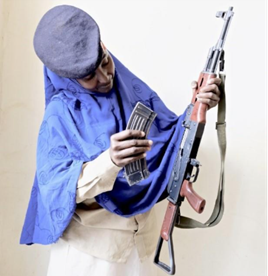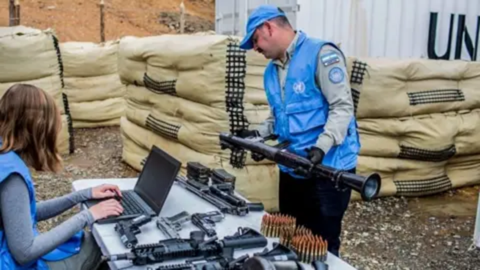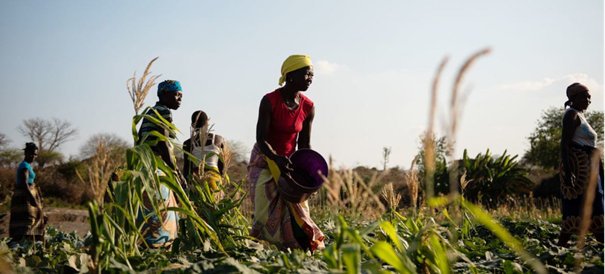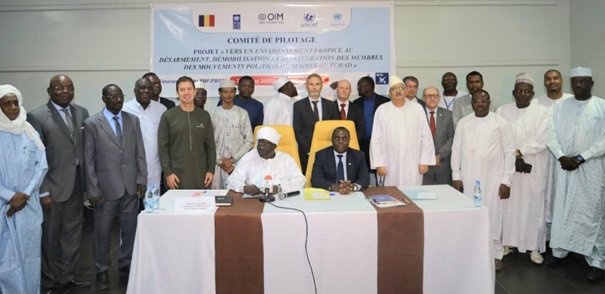
The DDR Section extends its sincere gratitude to its donors and key partners — including the Federal Republic of Germany, the Swiss Confederation, the Italian Republic, leading members of the Integrated DDR Training Group (IDDRTG) such as the Folke Bernadotte Academy (FBA), the Bonn International Center for Conflict Studies (bicc), the Kofi Annan International Peacekeeping Training Centre (KAIPTC), the Cairo International Center for Conflict Resolution, Peacekeeping and Peacebuilding (CCCPA), and the International Peace Support Training Centre (IPSTC), as well as the African Union (AU), the European Union External Action Service (EEAS), and the Inter-Agency Working Group on DDR — whose support has been instrumental in enabling essential DDR capacity-building initiatives.
CONTENTS
Introduction.
DDR AND THE UN PEACE AND SECURITY PILLAR
2.
35 years of UN Secretariat support on DDR
3.
DDR–AN AGILE TOOLBOX FOR PATHWAYS OUT OF VIOLENCE
4.
The DDR Section
Conclusion.
Looking ahead: DDR reform and the future of the UN peace and security pillar
1. Introduction
DDR AND THE UN PEACE AND SECURITY PILLAR
On the 26 of June 2025, the United Nations celebrated the 80th anniversary of its founding document, the UN Charter. Over the past eight decades, the UN has been a central actor in conflict prevention, peacebuilding, peacekeeping, and post-conflict recovery. One of the essential components of this effort is the commitment to disarmament. In the early years of the United Nations, disarmament efforts were primarily focused on states; notably through treaties addressing nuclear weapons and conventional arms control. It was not until the 1990s that a more operational approach began to take shape, with an increasing focus on disarming individuals and armed groups involved in internal conflicts.
In 1989, El Salvador became the first context in which the UN Security Council issued a Peacekeeping mission mandate that explicitly included DDR components. This mandate marked the beginning of the UN’s engagement in supporting DDR. In this context, DDR initially emerged as an essential tool in post-conflict settings as part of peace agreements.
To coordinate and support these efforts, the United Nations Secretariat established a dedicated DDR Section in 2007 to centralize expertise, guidance, and implementation policies and strategies. Over the years, the nature of conflicts has changed dramatically and with this, DDR evolved beyond its original post-conflict framework to address a broader range of contexts and challenges, including processes in ongoing conflicts where no peace agreement has been reached, community violence, urban insecurity, the regionalization of conflicts, and the uncontrolled proliferation of weapons. Today’s conflicts are increasingly fragmented, with a proliferation of non-state armed groups operating at multiple levels – local, national, regional, and international – and ranging from armed groups with political agendas and economic grievances to those designated as terrorist organizations, as well as criminal networks, gangs, and local self-defense groups. This growing complexity is further exacerbated by the impacts of climate change, the spread of illicit arms, and emerging threats such as cyber warfare and the widespread use of drones.
Consequently, the 80th anniversary of the United Nations is more than a celebration; it is a time to reflect on past achievements, reassess today’s challenges, and look toward the future. As the world faces unprecedented and interconnected crises, the UN is affected in all its pillars. In the Pact for the Future adopted in 2024, and recalled by Secretary-General António Guterres when presenting the UN80 reform, Member States clearly reaffirmed that « the United Nations has an indispensable role in the maintenance of international peace and security » and recognized « the interdependence of international peace and security, sustainable development and human rights » while also underscoring « the importance of the rule of law at international and national levels ».
In this context, as we reflect on the Organization’s evolution, the story of DDR offers a powerful lens through which to understand how the UN has adapted, one of its key peace and security tools, over the past 35 years to support sustainable peace in increasingly complex environments.
2. 35 years of UN Secretariat support on DDR
*The boundaries and names shown and the designations used on the maps on this site do not imply official endorsement or acceptance by the United Nations. See Terms of Use.
Peacekeeping Operations
Special Political Missions
Non-Mission Settings
Multiple types of contexts
Over the past 35 years, the United Nations has supported Disarmament, Demobilization, and Reintegration (DDR) processes across more than 30 countries and integrated DDR into more than 20 peace operations, adapting to changing political landscapes, evolving conflict dynamics, and local needs.
The United Nations was first requested to support DDR in 1989 in Central America, particularly in El Salvador, and continues today. Beyond statistics, DDR has transformed the lives of thousands of individuals and given them a second chance. Former combatants have transitioned into farmers, teachers, entrepreneurs, civic leaders and political figures.
This chapter provides an overview of key support provided by the UN Secretariat and highlights how that support has changed and adapted over decades.
Mozambique (since 2017)
In Mozambique, responding to a request from the UN Secretary-General’s Personal Envoy in 2018, the UN Secretariat played a vital advisory role to national authorities in supporting the implementation of the Maputo Peace Agreement between the Government of Mozambique and RENAMO forces. This included sharing best practices, disseminating the Integrated DDR Standards (IDDRS), and providing technical guidance on the disengagement, rehabilitation, and reintegration of members of insurgent groups.
In 2024, this support continued through a national conference on post-conflict reintegration, helping to shape Mozambique’s innovative approaches, such as integrating gender perspectives and leveraging technology in rural disarmament efforts. By sharing lessons from other contexts like Colombia and South Sudan, the UN Secretariat has been an essential partner to national stakeholders in designing and refining Mozambique’s DDR program, reinforcing its role in promoting sustainable peace through tailored, nationally owned DDR processes and guidance.
Republic of Congo (since 2017)
The first formal DDR request from a non-mission setting came in December 2017, when the Government of the Republic of Congo, via the Resident Coordinator, sought UN support to implement the Kinkala Agreement with the Ninja militia. In response, a joint UN technical assessment mission to Brazzaville in early 2018 provided context-specific recommendations in line with the Integrated DDR Standards (IDDRS). These findings shaped a successful Peacebuilding Fund (PBF) proposal centered on DDR, dialogue, and human rights, enabling the deployment of a dedicated DDR Officer.
Since then, the UN Secretariat has continued to provide strategic guidance, including during the review of the project’s first phase in 2019. As reintegration faced delays, the focus shifted to launching Community Violence Reduction (CVR) initiatives to address socio-economic drivers of conflict in the Pool region. These efforts aim to rebuild trust in state institutions, prevent remobilization, and ensure inclusive recovery, particularly for women and youth.
Cameroon (since 2019)
Cameroon is a country facing overlapping crises: Boko Haram violence in the Far North, separatist conflict in the North-West and South-West, and a refugee influx from the Central African Republic. In response, a 2018 Presidential Decree established the National DDR Committee, which now operates transitional centers across affected provinces.
As DDR is a new domain for Cameroon, support to building national capacity was essential. The UN Secretariat has supported the national authorities by providing strategic advice, training in DDR and CVR for stakeholders, and supporting the development of an Operational Manual. At the center of UN Secretariat support was strengthening the nationally led DDR process and fostering South-South cooperation whereby Cameroon exchanged with Colombia, learning from its experience.
Chad (since 2017)
Since 2017, at the request of Chadian authorities and the UN Resident Coordinator, the DDR Section provided technical assistance for two critical processes in Chad: the reintegration of members from politico-military groups and the voluntary exit of individuals associated with Boko Haram. Building on a 2021 directive from the UN Executive Committee, the Section partnered with the Bonn International Center for Conflict Studies (Bicc) to conduct a comprehensive study of DDR efforts in Chad and deployed a DDR expert from late 2021 to early 2022 to support coordination on the ground.
A major milestone came in April 2024, when the DDR Section, together with IOM and BICC, supported the development and adoption of Chad’s National DDRR Strategy. This nationally owned framework aims to provide sustainable reintegration pathways for former members of violent extremist organizations, including Boko Haram and the Islamic State – West Africa Province (ISWAP).
Yet, Chad’s experience also illustrates the inherent challenges of implementing DDR outside the framework of a traditional UN peacekeeping mission. Institutional fragmentation, lack of transparency, and competing mandates among national bodies have eroded trust in the process. The Special Technical Committee (CTS), tasked with overseeing DDR, has faced operational setbacks and credibility issues. These challenges have been further complicated by the transitional government’s fragile legitimacy, weak coordination with international actors, and the broader political-security landscape.
Despite these obstacles, the case of Chad highlights the strategic importance of DDR support, strengthening international coordination while reinforcing national ownership of the process.
DDR Support in Peacekeeping operations
Since the early 1990s, United Nations peacekeeping operations have played a central role in supporting DDR in post-conflict settings, to implement comprehensive peace or ceasefire agreements. Peacekeeping operations have been deployed in highly volatile contexts, where restoring stability and creating space for political processes required addressing the immediate security challenges posed by armed groups. With multidimensional mandates, robust field presences, and strong logistical capacities, peacekeeping operations have provided the operational backbone for some of the most comprehensive DDR programmes.
These missions oversaw the disarmament and demobilization of tens of thousands of combatants and supported their reintegration into civilian life. Peacekeeping operations also pioneered innovative approaches, such as community violence reduction (CVR) initiatives, and cross-border repatriation of foreign combatants.
El Salvador (1989) – First request for UN support on DDR
1989 marks a key milestone for DDR, as the first formal reference to DDR appeared in Security Council Resolution 637, within the Central American peace process, specifically focusing on El Salvador. The Security Council resolution acknowledged the importance of international verification to support commitments made by Central American presidents, including the voluntary demobilization, repatriation, or relocation of irregular forces, as outlined in the Costa del Sol Accord of 14 February 1989.
Thanks to UN efforts, between 1990 and 1992, a series of landmark agreements laid the groundwork for peace in El Salvador, culminating in the signing of the historic Peace Accords between the government of El Salvador and the Front Farabundo Martí de libération nationale (FMLN) in January 1992. These accords brought an end to twelve years of civil war that claimed approximately 80,000 lives.
This historic moment paved the way for the creation of the United Nations Observer Mission in El Salvador (ONUSAL) which monitored the ceasefire and verified the Disarmament, Demobilization and Reintegration (DDR) programes as part of the broader peace accord. For the first time, DDR was integrated into a UN peacekeeping mission.
ONUSAL reported 8,552 FMLN forces demobilized, including 38 percent (3,285 individuals) were women and 18 percent (1,500 to 1,600) under the age of eighteen. By 1994, ONUSAL reported that a total of 15,009 FMLN members had been demobilized, including 4,492 women.
Sierra Leone (1999–2005) – First implementation of the Stop Gap Program
After more than a decade of civil war, Sierra Leone emerged in the early 2000s with a fragile peace, and an urgent need to rebuild. The conflict, which began in 1991, left deep scars: thousands dead, entire communities displaced, and a generation of children torn from their families and forced into armed groups. In this context, DDR became one of the most vital tools for national recovery.
The peace process gained momentum in 1999, when the Lomé Peace Agreement between the government and the Revolutionary United Front (RUF) laid the foundation for ending hostilities. The agreement called for a nationwide DDR programme to dismantle the fighting forces and reintegrate former combatants into civilian life, supported by the United Nations Mission in Sierra Leone (UNAMSIL).
Over the course of the programme, which lasted until February 2004, a total of 72,490 combatants were disarmed and demobilized. Among them were combatants from all factions: the RUF, the Civil Defence Forces (CDF), the Armed Forces Revolutionary Council (AFRC), and the national army. Importantly, over 6,800 child soldiers were also identified, demobilized, and placed into specialized reintegration support programmes, often with the help of UNICEF and child protection NGOs.
Women and girls, many of whom had been abducted, exploited, or forced into combat and support roles, were also included in the process. While many initially went unrecognized due to narrow entry criteria that defined “combatants” strictly, subsequent efforts expanded eligibility to include camp followers and women associated with armed groups. Roughly 5,000 women participated in various stages of the DDR programme.
The StopGap programme offered labour intensive, quick-impact community infrastructure and agricultural development projects which employed some 6,000 ex-combatants as well as 1,500 community members, thus facilitating the reintegration of ex-combatants into their communities. Psychosocial support mechanisms contributing to better reintegration included communal work, dining and recreational activities. This programme was aimed at rehabilitation of not only the physical and economic infrastructure of communities but also their social infrastructure by rebuilding confidence. The innovative approach of this ambitious programme earned it the UN21 Award.
Despite numerous logistical and political challenges, including resurgences of violence in the early stages, the Sierra Leone DDR programme is often cited as one of the most successful post-conflict demobilization efforts in Africa. It played a crucial role in stabilizing the country and laying the groundwork for long-term peace and development.
Democratic Republic of the Congo (since 2002) - Repatriation of foreign armed combatants
The Democratic Republic of the Congo (DRC) has long faced the challenge of managing multiple, overlapping armed conflicts, many of which involve foreign armed groups operating within its borders. In this context, the Disarmament, Demobilization, Repatriation, Reintegration, and Resettlement (DDRRR) programme, the UN’s longest-running, largest, and most complex programme to repatriate foreign combatants, became a central pillar of the peace consolidation process.
Initially launched in 2002 under the mandate of the United Nations Mission in the DRC (MONUC) following the Lusaka Ceasefire Agreement (1999), DDRRR was continued and expanded by the United Nations Organization Stabilization Mission in the DRC (MONUSCO) after its establishment in July 2010. The presence in the DRC of foreign armed groups from its eastern neighbors, particularly the Democratic Forces for the Liberation of Rwanda (FDLR), the Allied Democratic Forces (ADF) from Uganda, and armed groups from Burundi, South Sudan, and the Central African Republic, became a persistent source of instability.
Alongside these foreign armed groups existed a wide array of Mai-Mai or local Congolese self-defense groups, estimated at 20,000–30,000 combatants in 2002. These Congolese groups both fought against and, at times, collaborated with foreign armed groups. While Congolese armed groups were to be addressed through a separate Congolese national DDR process, their presence not only heightened instability but also provided a pool of potential recruits for foreign forces.
Over the next 23 years, DDRRR worked systematically to whittle away at foreign armed groups, combining sustained field engagement with robust logistical support. The programme established an extensive field presence throughout eastern DRC, capable of maintaining direct communication with foreign combatants and encouraging their voluntary return to their countries of origin. Partnerships with humanitarian agencies ensured that women and children associated with armed groups received specialized protection and support.
Although instability still prevails in parts of eastern DRC, the results of the UN DDRRR programme are impressive. Between 2002 and 2024, DDRRR repatriated 32,818 members of foreign armed groups, of which 18,307 were combatants and 14,511 were dependents. In addition, between 2009 and 2024, the programme extracted 14,267 Congolese combatants, of which 5,232 were associated with foreign armed groups. In both categories, the majority were linked to the FDLR, whose numbers declined sharply to an estimated 500–600 combatants between 2015 and 2021. These figures do not include the tens of thousands of refugees transferred to the UN Refugee Agency (UNHCR) for protection, nor the thousands of Congolese combatants handed over to the national DDR process.
Liberia (2003–2018) – First time women associated with armed groups were considered as beneficiaries
The second Liberian civil war, which lasted from 1999 to 2003 took a devastating human toll. According to several reports, between 250,000 and 270,000 people lost their lives, while 850,000 were forced to seek refuge in neighboring countries, and another 500,000 were displaced within Liberia. In addition, a 2004 study revealed that 60 to 70 percent of the population experienced some form of sexual violence during the conflict, underscoring the deep trauma inflicted on civilians, especially women and girls.
In the wake of this devastation, a fragile hope began to take shape. Following the Comprehensive Peace Agreement (CPA) in 2003, the parties to the conflict appealed to the United Nations for support. In response, the United Nations Mission in Liberia (UNMIL) was launched in September 2003, tasked with helping the newly formed National Transitional Government restore stability and implement the CPA. A cornerstone of UNMIL’s mandate was to design and implement a Disarmament, Demobilization, Rehabilitation, and Reintegration (DDRR) programme for Liberia’s tens of thousands of ex-combatants.
In less than two years, the DDRR programme marked a major milestone: by October 31 2004, 101,496 combatants and their “associates” had been disarmed and demobilized. Recognizing the specific roles and needs of women in the conflict, the programme also introduced group disarmament criteria that helped ensure their inclusion. As a result, 22,370 women were successfully disarmed and demobilized, a significant achievement in Liberia’s post-conflict recovery. Eligibility criteria were loosened, expanding the programme’s reach from 30,000 to 100,000 beneficiaries, and including Women Associated with Armed Groups for the first time. To support sustainable reintegration, the programme also partnered with the private sector, creating employment pathways for both former combatants and women participants.
Another major focus of the DDRR strategy was the plight of Children Associated with Armed Forces and Armed Groups (CAAFAG), who had been used extensively by all factions. With the active involvement of UNICEF, the programme prioritized the demobilization and protection of child combatants. In total, 10,972 children, 8,532 boys and 2,440 girls, were disarmed and reintegrated into society.
But demobilization was only the beginning. The next crucial phase, rehabilitation and reintegration, aimed to transform ex-combatants into citizens. Approximately 90,000 ex-combatants enrolled in programmes offering formal education, vocational training, and apprenticeship opportunities, helping them rebuild their lives and contribute to a peaceful, post-war Liberia.
Haiti (since 2006) – First mandate on Community Violence Reduction
In Haiti, the United Nations’ approach to DDR had to be fundamentally reimagined considering the country’s unique security dynamics. Unlike conventional post-conflict environments characterized by organized armed forces or rebel groups, Haiti’s instability was rooted in pervasive community violence and the dominance of armed gangs. Recognizing this reality, Security Council Resolution 1702 (2006) explicitly noted that conditions for DDR did not exist in Haiti and that alternative initiatives were required to address local conditions. In response, the United Nations Stabilization Mission in Haiti (MINUSTAH) launched a Community Violence Reduction (CVR) strategy, thus marking a significant shift in how DDR was conceptualized and operationalized.
First initiated in 2006, CVR became the centerpiece of the UN’s engagement to reduce violence and promote reintegration in Haiti. In 2007, MINUSTAH formally re-oriented its DDR strategy, prioritizing CVR to address the major root causes of violence such as poverty, social exclusion, and the absence of the rule of law. Rather than focusing on traditional disarmament or cantonment, CVR emphasized community-level stabilization and socio-economic recovery. Initial CVR interventions were labor-intensive projects and temporary work programmes, designed to offer immediate alternatives to gang involvement and criminality for youth at-risk and vulnerable populations. As the programme evolved, more targeted activities included vocational training, small enterprise development, and private-sector apprenticeships, aiming to build durable livelihoods and foster long-term reintegration.
Beyond employment, CVR in Haiti also addressed broader dimensions of violence and fragility. Legal aid centres were established to increase access to justice, particularly for marginalized groups. Community-based policing initiatives sought to restore trust between local populations and security actors. Social reinsertion projects supported former inmates, including women and minors, helping them reintegrate into their communities with dignity and purpose. These interventions reflected a holistic understanding of DDR, one that went beyond weapons collection to focus on prevention, resilience, and community transformation.
Darfur, Sudan (2007-2020) – Implementation of award-winning Community-based Labor-Intensive Projects (CLIPs)
The Darfur Peace Agreement (DPA), signed in 2006 between the Government of Sudan and a major rebel faction, the Sudan Liberation Movement/Army (SLM/A), with the support of the African Union (AU), the United Nations, and other partners, marked the first major milestone in Darfur’s long and complex peace process. DDR was placed at the core of the DPA’s final security arrangements. UN DDR advisors played a direct role in the Darfur peace talks, providing technical assistance to the parties and supporting the drafting of the agreement to ensure DDR provisions were practical, implementable, and aligned with international standards.
In 2008, as anticipated in the peace framework, the UN and AU deployed the unprecedented hybrid operation in Darfur (UNAMID), established under Security Council Resolution 1769 (2007). Recognizing the limitations of implementing formal DDR in Darfur’s volatile context, UNAMID’s DDR Section adapted the Community Violence Reduction (CVR) approach to local realities, creating Community-based Labor-Intensive Projects (CLIPs) as a distinctive violence reduction and stabilization tool. Operational by mid-2012, CLIPs bridged the gap between unemployed youth and the lack of vocational opportunities by offering high-demand skills training, such as welding, metal work, carpentry, and computer literacy, enabling participants to later establish their own businesses. In parallel, at-risk youth were engaged in short-term employment through construction projects, learning on the job while building vital infrastructure such as schools and hospitals.
Much like the CVR experience in Haiti, CLIPs proved highly successful in Darfur. In October 2014, the programme received the UN21 Award for Outstanding Vision, recognizing its tangible contribution to peace and stabilization. The impact was substantial: 98% of participating youth reported gaining essential livelihood skills for securing employment, nearly 70% expressed confidence in finding jobs post-training, and 67–68% stated the programme had a strong positive effect on community cohesion and peacebuilding in their areas. Environmental benefits also emerged, as some participants were trained in producing environmentally friendly soil-stabilized blocks and fuel-efficient stoves, adding a sustainability dimension to the programme’s achievements.
In early 2015, CLIPs evolved into Community Stabilization Projects (CSPs), expanding the scope from economic reintegration to a more comprehensive approach aimed at promoting community security, strengthening governance and institutional development, enhancing access to basic services, and creating durable solutions for conflict-affected communities. These CSPs operated until 2019, directly contributing, though not always officially acknowledged, to the fulfillment of UNAMID’s DDR-related mandate.
When UNAMID’s DDR programme in Darfur concluded in May 2019, it left behind a proven model of community-centered stabilization. By the time UNAMID’s overall mandate ended on 31 December 2020, the mission’s CVR-type activities had demonstrated that in contexts where formal DDR is constrained; targeted, locally owned, and skill-oriented community projects can both reduce violence and lay the foundations for sustainable peace.
DDR SUPPORT IN SPECIAL POLITICAL MISSIONS
In addition to Peacekeeping Operations, the international community has relied on Special Political Missions (SPMs) to address a wide range of complex threats to international peace and security. SPMs have a wide variety of mandates, structures, and operational profiles, ranging from headquarters-based special envoys to field-based missions with complex, multidimensional mandates. These missions are centered on diplomacy and good offices and serve as vital operational platforms to support political processes and mediation efforts.
DDR has been a key component of these missions, since BINUCA was established in the Central African Republic in 2009 and progressively integrated into mandates given to Special Representatives of the Secretary-General. Over time, DDR has proven essential in stabilizing fragile contexts and supporting transitions out of conflict.
For DDR to effectively adapt to these political mission settings, its implementation structures and partnerships were adjusted. While in peacekeeping operations DDR mandates typically included the implementation of DDR programs, DDR mandates in special political missions usually encompass tailored technical and strategic advice. Supporting DDR in these contexts often requires additional financial resources. This may involve voluntary contributions or the establishment of alternative funding mechanisms, such as dedicated multi-donor trust funds, to enable integrated DDR planning and implementation outside the UN’s regular budget.
SOMALIA (since 2013) – DDR mandate to support voluntary disengagement from a violent extremist group
Somalia has faced decades of conflict marked by political instability, clan rivalries, and extremist groups. Since the collapse of the central government in 1991, the country has struggled with the rule of law, humanitarian crises, and ongoing violence. Al-Shabaab continues to pose a significant threat, carrying out attacks against civilians and government forces. Beyond Al-Shabaab, non-state armed groups, many of which are clan-based militias, control territory, collect taxes, and provide security or justice in the absence of effective state governance. While some operate independently, others are aligned with political actors or external sponsors, complicating the conflict landscape. Together, these groups undermine national security, disrupt humanitarian aid delivery, and hinder efforts toward lasting peace and state-building. In this complex security landscape, a reengineered DDR approach focused on disengagement from Al-Shabaab emerged as a critical tool, not only to provide immediate stabilization but also to lay the groundwork for reconciliation by ensuring ex-combatants can return and contribute positively to their communities.
Since 2013, the United Nations Assistance Mission in Somalia (UNSOM) and since 2024 the United Nations Transitional Assistance Mission in Somalia (UNTMIS) have supported DDR as part of the mandate to assist the Federal Government of Somalia (FGS) in promoting peacebuilding in the country. In response to defections from Al-Shabaab, the FGS, with support from the UN, launched the “National Programme on the Treatment and Handling of Disengaged Combatants” in 2012 – the National Defector Rehabilitation Programme (DRP). This initiative was designed to support stability by facilitating the reintegration of former combatants into civilian life. Through this programme, the UN supported the disengagement of approximately 6,500 low-risk Al Shabaab defectors and their rehabilitation/reintegration through formal pathways. The UN also supported the consolidation of a gender-responsive approach that enabled the rehabilitation of 1,200 female Al Shabaab members since 2018.
Colombia (since 2016) – UN support to monitor and verify a national DDR programme
The Colombian peace process with the Fuerzas Armadas Revolucionarias de Colombia – Ejército del Pueblo (FARC-EP) marked a turning point in the way DDR is conceived and implemented. Colombia’s DDR process was nationally owned and politically negotiated, with the United Nations providing verification, accompaniment, and advisory support rather than acting as a direct implementer.
The process was formalized with the adoption of UN Security Council Resolution 2261 (2016), which created the UN Mission in Colombia to verify the ceasefire and the laying down of arms. A tripartite mechanism, involving the UN, the FARC-EP, and the Government, registered, stored, and destroyed more than 8,000 weapons. By September 2017, the FARC had completed its disarmament and formally transformed into a political party.
To support the longer-term reintegration of ex-combatants, Resolution 2366 (2017) established the UN Verification Mission in Colombia, which focused on monitoring socioeconomic and political reintegration efforts and ensuring security guarantees for ex-FARC members and conflict-affected communities.
At the center of the Colombian model was the Agency for Reintegration and Normalization (ARN), which led the DDR process. Its programs notably focused on rural development, community initiatives, and political participation, seen to build long-term legitimacy.
Despite these achievements, challenges persist. Security threats from criminal groups, FARC dissidents, and other armed actors continue to endanger former combatants and communities, particularly in remote rural areas. Many ex-combatants still struggle with limited access to land, livelihoods, and basic public services, while social acceptance remains inconsistent. The UN Verification Mission’s mandate has been extended multiple times, underlining the ongoing nature of reintegration and the need for continued international support.
Yet Colombia’s DDR remains a landmark example of nationally owned peacebuilding. By empowering national institutions like the ARN, the DDR process fostered national and local ownership and laid the groundwork for a more sustainable peace.
DDR SUPPORT IN NON-MISSION SETTINGS
Non-mission settings are generally considered situations where there is no United Nations peace operation deployed, be it a Peacekeeping Operation (PKO), a Special Political Mission (SPM), regional and liaison offices, or country-specific good office arrangements such as a Special Envoy. Support to non-mission settings is not an entirely new spectrum within the field of DDR. In such settings, DDR has commonly taken place either without any involvement on the part of the United Nations, or with targeted support from agencies, funds, and programmes as part of a United Nations Country Team (UNCT).
Since the UN Peace and Security reform took effect in 2019, the DDR Section in the UN Secretariat has been mandated as the system-wide service provider for DDR, with a clear role to respond systematically to requests for support. Building on years of support to Peacekeeping operations and Special Political Missions, national authorities, Resident Coordinators and regional organizations now are able to request support directly from the UN Secretariat
This shift is reflected in the latest update of the Integrated DDR Standards (IDDRS) and the new United Nations Approach to DDR launched in 2019, developed jointly by the Inter-Agency Working Group on DDR that is co-chaired by the DDR Section and UNDP. Together, these developments signal a transformative step forward, positioning DDR as a flexible, responsive tool ready to meet the evolving demands of peace and security in today’s complex and evolving conflict landscapes.
Mozambique (since 2017)
In Mozambique, responding to a request from the UN Secretary-General’s Personal Envoy in 2018, the UN Secretariat played a vital advisory role to national authorities in supporting the implementation of the Maputo Peace Agreement between the Government of Mozambique and RENAMO forces. This included sharing best practices, disseminating the Integrated DDR Standards (IDDRS), and providing technical guidance on the disengagement, rehabilitation, and reintegration of members of insurgent groups.
In 2024, this support continued through a national conference on post-conflict reintegration, helping to shape Mozambique’s innovative approaches, such as integrating gender perspectives and leveraging technology in rural disarmament efforts. By sharing lessons from other contexts like Colombia and South Sudan, the UN Secretariat has been an essential partner to national stakeholders in designing and refining Mozambique’s DDR program, reinforcing its role in promoting sustainable peace through tailored, nationally owned DDR processes and guidance.
Republic of Congo (since 2017)
The first formal DDR request from a non-mission setting came in December 2017, when the Government of the Republic of Congo, via the Resident Coordinator, sought UN support to implement the Kinkala Agreement with the Ninja militia. In response, a joint UN technical assessment mission to Brazzaville in early 2018 provided context-specific recommendations in line with the Integrated DDR Standards (IDDRS). These findings shaped a successful Peacebuilding Fund (PBF) proposal centered on DDR, dialogue, and human rights, enabling the deployment of a dedicated DDR Officer.
Since then, the UN Secretariat has continued to provide strategic guidance, including during the review of the project’s first phase in 2019. As reintegration faced delays, the focus shifted to launching Community Violence Reduction (CVR) initiatives to address socio-economic drivers of conflict in the Pool region. These efforts aim to rebuild trust in state institutions, prevent remobilization, and ensure inclusive recovery, particularly for women and youth.
Cameroon (since 2019)
Cameroon is a country facing overlapping crises: Boko Haram violence in the Far North, separatist conflict in the North-West and South-West, and a refugee influx from the Central African Republic. In response, a 2018 Presidential Decree established the National DDR Committee, which now operates transitional centers across affected provinces.
As DDR is a new domain for Cameroon, support to building national capacity was essential. The UN Secretariat has supported the national authorities by providing strategic advice, training in DDR and CVR for stakeholders, and supporting the development of an Operational Manual. At the center of UN Secretariat support was strengthening the nationally led DDR process and fostering South-South cooperation whereby Cameroon exchanged with Colombia, learning from its experience.
Chad (since 2017)
Since 2017, at the request of Chadian authorities and the UN Resident Coordinator, the DDR Section provided technical assistance for two critical processes in Chad: the reintegration of members from politico-military groups and the voluntary exit of individuals associated with Boko Haram. Building on a 2021 directive from the UN Executive Committee, the Section partnered with the Bonn International Center for Conflict Studies (Bicc) to conduct a comprehensive study of DDR efforts in Chad and deployed a DDR expert from late 2021 to early 2022 to support coordination on the ground.
A major milestone came in April 2024, when the DDR Section, together with IOM and BICC, supported the development and adoption of Chad’s National DDRR Strategy. This nationally owned framework aims to provide sustainable reintegration pathways for former members of violent extremist organizations, including Boko Haram and the Islamic State – West Africa Province (ISWAP).
Yet, Chad’s experience also illustrates the inherent challenges of implementing DDR outside the framework of a traditional UN peacekeeping mission. Institutional fragmentation, lack of transparency, and competing mandates among national bodies have eroded trust in the process. The Special Technical Committee (CTS), tasked with overseeing DDR, has faced operational setbacks and credibility issues. These challenges have been further complicated by the transitional government’s fragile legitimacy, weak coordination with international actors, and the broader political-security landscape.
Despite these obstacles, the case of Chad highlights the strategic importance of DDR support, strengthening international coordination while reinforcing national ownership of the process.
Chapter's conclusion
Over the past three decades, both the nature of armed conflicts and the expectations placed on the United Nations have changed dramatically. Conflicts have become increasingly fragmented, localized, and protracted. Non-state armed actors have multiplied and fragmented. Transnational dynamics have increased and weakened or contested state authority beyond own borders. In response, the United Nations’ approach to DDR has had to evolve.
Originally a component of comprehensive peace agreements as a traditional DDR programme and therewith a part of peacekeeping mission mandates, DDR has over three decades progressively transformed into a flexible, adaptive toolbox, capable of responding to a wide array of contexts and needs. Today, DDR tools are utilized in environments where no peace agreement has been reached and drivers of violence persist. This shift has been driven by the changing nature of conflict. In response, the United Nations adapted and made it possible for Member States, Resident Coordinators and regional actors, to seek targeted and context-specific support on DDR from the UN Secretariat and UN family, in the absence of peace agreements and large-scale peace operations.
The 2019 institutional reform of the UN Peace and Security Architecture adapted the UN’s approach to DDR. As such, DDR is now understood not only as a technical process but also as a strategic entry point for broader peacebuilding, conflict prevention, and political engagement. The integration of approaches such as Community Violence Reduction (CVR) and the revision of the Integrated DDR Standards (IDDRS) further demonstrate DDR’s continued capacity to adapt to new challenges.
Ultimately, DDR’s agility illustrates the capacity of this peacebuilding tool to evolve alongside the changing nature of conflict and international engagement, reaffirming its continued relevance in an increasingly complex conflict landscape.
3. DDR-AN AGILE TOOLBOX FOR PATHWAYS OUT OF VIOLENCE
Add the Video: “Understanding DDR and its evolution” here
DDR-related Tools
While traditional DDR programmes following a peace agreement remain essential for sustaining peace, conflict situations where the preconditions are not met do not allow for their immediate implementation.
To respond to these changing realities, the United Nations can support through what are called DDR-related tools. These are flexible, targeted initiatives that help manage ex-combatants and stabilize communities when a traditional DDR programme is not, or not yet possible, or to support a traditional DDR programme.
VISUAL: Video “Enhancing Responses to today’s conflicts: DDR-Related Tools for complex security challenges”
Your content goes here. Edit or remove this text inline or in the module Content settings. You can also style every aspect of this content in the module Design settings and even apply custom CSS to this text in the module Advanced settings.
Evolution of DDR: Four Generations
Over the years, several major shifts in the nature and dynamics of conflicts have occurred:
REGIONALIZATION
Conflicts have become increasingly regionalized, spilling across borders and involving multiple state and non-state actors, making the disarmament of combatants more complex.
LACK OF PEACE AGREEMENTS
Formal peace agreements have become less frequent. This has reduced the opportunity for DDR programmes which, as part of such formal agreements, disarm, demobilize and reintegrate the members of an armed group that has signed a peace or ceasefire agreement. Challenges with non-state armed groups nevertheless persist requiring new, more adaptive approaches.
VIOLENT EXTREMISM
The rise of violent extremism has blurred the lines between ideological radicalization and armed violence, challenging traditional DDR frameworks and fostering the development of DDR-related initiatives.
COMMUNITIES
Finally, the role of communities has become more essential than ever; reintegration is no longer seen as an individual process for ex-combatants, but as a collective effort whereby communities are active partners in reconciliation and recovery.
REGIONALIZATION
Conflicts have become increasingly regionalized, spilling across borders and involving multiple state and non-state actors, making the disarmament of combatants more complex.
LACK OF PEACE AGREEMENTS
VIOLENT EXTREMISM
The rise of violent extremism has blurred the lines between ideological radicalization and armed violence, challenging traditional DDR frameworks and fostering the development of DDR-related initiatives.
COMMUNITIES
Finally, the role of communities has become more essential than ever; reintegration is no longer seen as an individual process for ex-combatants, but as a collective effort whereby communities are active partners in reconciliation and recovery.
To cater to these shifts, the United Nations has adapted the DDR toolbox to respond to these increasingly complex conflict environments. The evolution of DDR and its use has often been described by practitioners and experts as the “three generations of DDR approaches” each generation reflecting the adaptation to new challenges, from classical post-conflict settings with a peace agreement to violent extremism and community-driven reintegration in the absence of formal peace agreements.
By focusing on the immediate needs of individuals and communities affected by armed groups, DDR-related tools play a crucial role in reducing violence, supporting stabilization, and laying the groundwork for long-term reintegration. Here are some Implementation Examples.
4.THE DDR SECTION
The DDR Section
The DDR Section (DDRS) is the only team in the UN Secretariat that deals with the management of armed groups. The Section serves as a global service provider and a center of excellence on DDR and dealing with armed groups. The Section works across the entire peace continuum with UN entities, Member States, Regional Organizations and other partners towards mitigating the threats posed by armed groups, encouraging their members to lay down their arms, demobilize and reintegrate into civilian life.
For over 35 years, the United Nations has supported DDR processes around the world. Eighteen years ago, the establishment of the DDR Section within the Department of Peace Operations marked a turning point in consolidating institutional expertise and streamlining this support. In 2019, as part of the peace and security pillar reform, the Section was further strengthened with a formal mandate to serve as a UN-wide service provider. This evolution reflects the UN’s agility in adapting its structures and mechanisms to respond to the changing needs and requests of Member States, ensuring that DDR support remains fit for purpose across diverse and evolving contexts.
DDRS Services and Support
The DDR Section offers a range of specialized services. In 2024 and January to June 2025 , the DDR Section deployed to over 35 contexts worldwide to support national authorities, regional organizations, the UN system, partners and stakeholders.
*The boundaries and names shown and the designations used on the maps on this site do not imply official endorsement or acceptance by the United Nations. See Terms of Use.
The support provided spans the following areas:
Collective collaboration through partnerships
A collective commitment across the UN and a plurality of actors
While the DDR Section aims to ensure coherence and technical guidance on the implementation of DDR, the success of this tool relies on national and local ownership and active participation of UN agencies, national authorities, grassroots actors, and specialized NGOs. DDR is a complex process that no single entity or agency can implement by itself. This plurality of stakeholders is also essential to ensuring that DDR strategies and implementation are context-specific, politically grounded, and socially inclusive, laying the foundations for sustainable peace and long-term stability. The DDR Section therefore nurtures strong strategic, policy and operational partnerships with other leading DDR institutions, think tanks, INGOs, training centers, UN Member States, regional organizations and more.
Add visual DDR Section relationships
Your content goes here. Edit or remove this text inline or in the module Content settings. You can also style every aspect of this content in the module Design settings and even apply custom CSS to this text in the module Advanced settings.
Inter-governmental organizations
- European Union (EU)
- North Atlantic Treaty Organization (NATO)
- Organization for Security and Co-operation in Europe (OSCE)
Key Donors
- Denmark
- European Union
- Germany
- Italy
- Sweden/ Folke Bernadotte Academy (FBA)
- Switzerland
- United Kingdom
The United Nations Inter-Agency Working Group (IAWG) on DDR
Established in 2005 by six founding entities, the Interagency Working Group on DDR (IAWG-DDR) is a UN joint effort to enhance the planning, implementation, and monitoring of DDR. Now turning 20 in 2025, the IAWG-DDR has grown to include 27 entities, as well as observers and strategic partners, reflecting the relevance of DDR across the peace and security, development and humanitarian pillars. It is co-chaired by the DDR Section in DPO and UNDP.
Over 20 years, the group has developed and maintained the UN Integrated Disarmament, Demobilization and Reintegration Standards (IDDRS), provided training, monitored developments, and shared insights on field operations.
In 2025-2026, the IAWG-DDR will celebrate two milestones: 20 years since its establishment (March 2025) and 20 years since the first IDDRS publication (2026). The IDDRS are a comprehensive guidance framework for the UN, DDR practitioners and those who wish to make use of it.
Think Tanks and INGOs
The DDR Section collaborates with leading think tanks and international NGOs to enhance knowledge, analysis, and policy innovation on DDR. The engagement ranges from joint projects and Memoranda of Understanding (MoUs), to joint facilitation of workshops and trainings, and knowledge exchange.
Key partners include the Bonn International Center for Conflict Studies (BICC), the Cairo International Center for Conflict Resolution, Peacekeeping and Peacebuilding (CCCPA), the Berghof Foundation, the Armed Conflict Location & Event Data Project (ACLED), the International Institute for Strategic Studies (IISS), the Global Community Engagement and Resilience Fund (GCERF), the International Peace Institute (IPI), the United States Institute of Peace (USIP), and the Managing Exits from Armed Conflict Project of the United Nations Institute for Disarmament Research (UNIDIR’s MEAC Project), among others.
Training Institutions: IDDRTG
The Integrated Disarmament, Demobilization and Reintegration Training Group (IDDRTG) is composed of international organizations and training institutes with a common goal of developing and sharing training materials related to DDR. The IDDRTG develops trainings for DDR practitioners both from international and regional organizations, military, police and NGOs, as well as scholars and government officials. Annually, the IDDRTG conducts and supports around one dozen DDR-related trainings or capacity-development workshops.
The IDDRTG was established as a response to the need for coordination between training institutes in developing and delivering training courses in order to meet the increasing need for highly qualified DDR practitioners, planners, trainers and policy makers. The IDDRTG has proven to be an extremely valuable resource in the operationalization of international guidelines on DDR and continues to deliver trainings to increase the capacities among colleagues currently working, or aspiring to work, in related environments.
MoUs with key partners
To strengthen collaboration and partnerships, the DDR Section has multiple Memoranda of Understanding (MoU) with key partners, including with UN agencies, national authorities and research institutions. Three examples are:
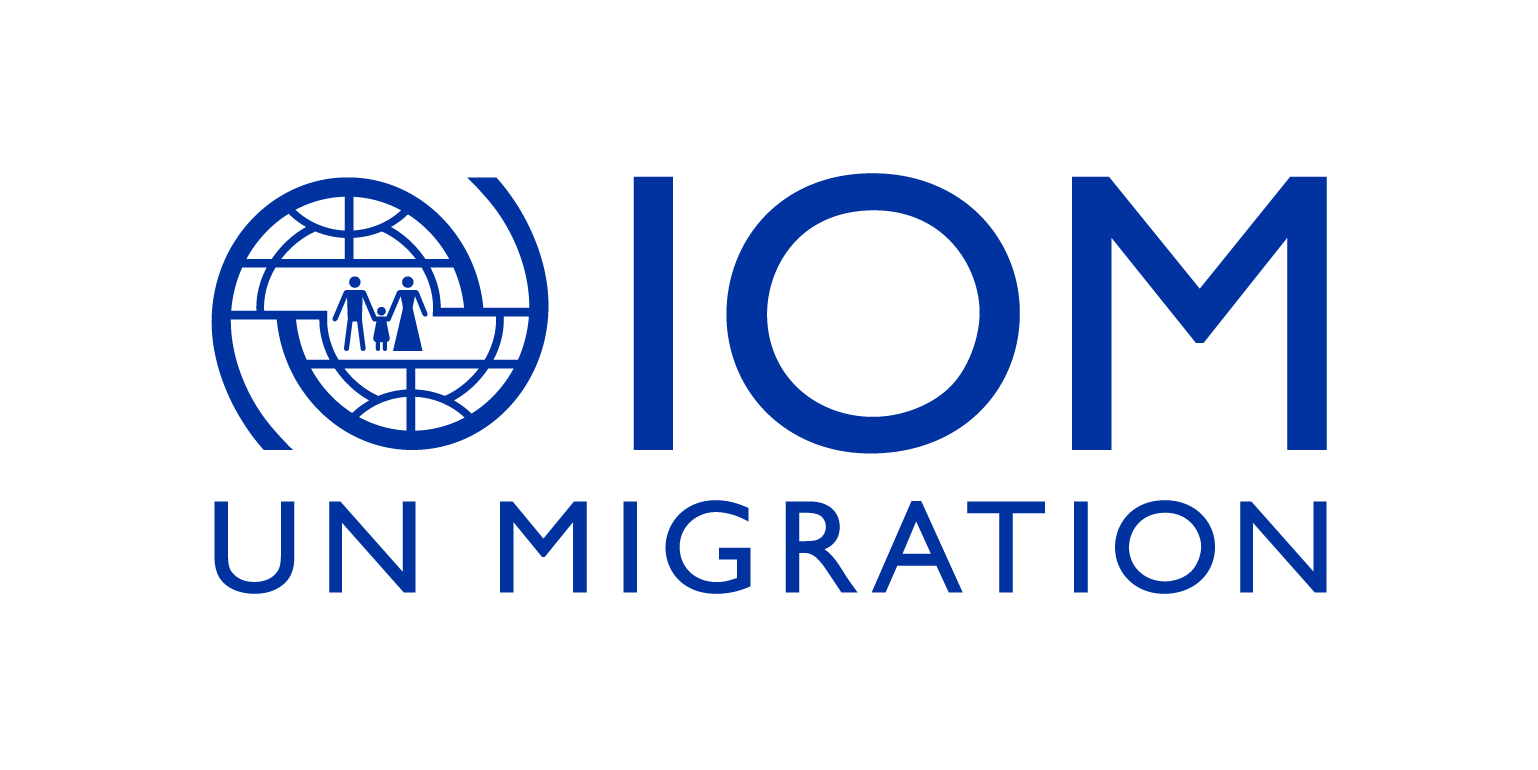
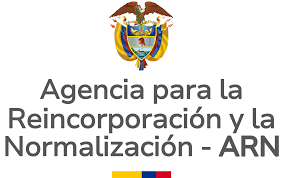

GROUP OF FRIENDS of DDR
In parallel to internal UN efforts, Member States have also played a vital role in advancing DDR through the Group of Friends of Disarmament, Demobilization and Reintegration (DDR), established on 21 May 2019. Co-chaired by Côte d’Ivoire and Egypt, the Group now brings together 16 Member States. The group has served as a valuable forum for information sharing, policy discussions, and coordinating advocacy for robust DDR and DDR-related tools programming that is people-centered and built on partnerships. Key achievements in the past five years include: (1) Raising awareness of the crucial role DDR plays in creating sustainable peace and security, which resulted in increased inclusion of Community Violence Reduction and Weapon and Ammunition Management aspects in peace operation mandates; (2) Advocating for adequate funding and political support for DDR, which resulted in the approval of a DDR budget in various missions and allocation of extrabudgetary funding to implement DDR initiatives; (3) Briefings by senior Mission Staff, Member States, and consultants on best practices, lessons learned, and raising awareness on DDR challenges, which has amplified voices from the field drawing from experiences of those impacted by conflict to ensure that DDR processes are nationally owned, locally led and context specific.
5. CONCLUSION
Looking ahead: DDR reform and the future of the UN peace and security pillar
Over the past 35 years, DDR has consistently demonstrated its capacity to evolve in response to shifting conflict dynamics. From its early applications in settings like El Salvador and Mozambique to more nationally led and politically negotiated processes such as in Colombia, DDR has moved beyond rigid, sequential models to become an agile, context-driven approach. As today’s peace and security challenges become increasingly complex, shaped by violent extremism, transnational crime, regionalization of conflicts, and climate shocks, DDR’s relevance has deepened. Its strength lies not only in its foundational pillars of disarmament, demobilization, and reintegration, but also in its growing toolbox of complementary measures tailored to diverse environments.
DDR is now as much about violence reduction and community resilience as it is about traditional post-conflict transitions. The DDR approach stands as a fundamental toolbox to address instability and foster peace by directly tackling the root causes at the heart of conflicts. As a tool in the UN’s peace and security architecture, it remains a vital mechanism for breaking cycles of violence, preventing relapse into conflict, and laying the groundwork for inclusive peace. Far from being static, DDR continues to adapt, responding to new realities with innovative tools and renewed partnerships to continue to support countries to find Pathways out of Violence.
The growing need for dealing with armed groups in increasingly complex conflict environments has reinforced the importance of a dedicated DDR Section within the United Nations where expertise, technical knowledge and lessons are pooled, making it today a central pillar of the UN’s peace and security architecture. Ultimately, the evolution of the DDR toolbox and the adaptation of UN Secretariat structures and mandates with the establishment of the DDR Section in 2007 and its mandate as a system-wide service provider in 2019 is a testament to its agility, enduring relevance, and its central role in the pursuit of sustainable peace.
